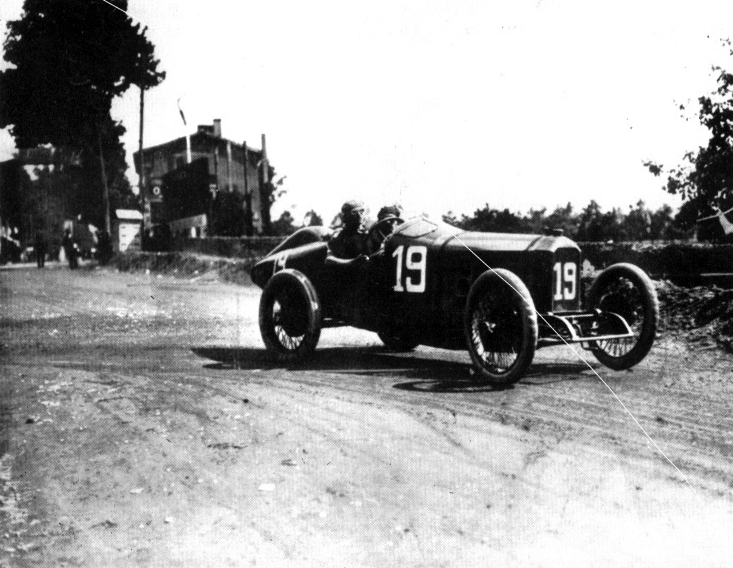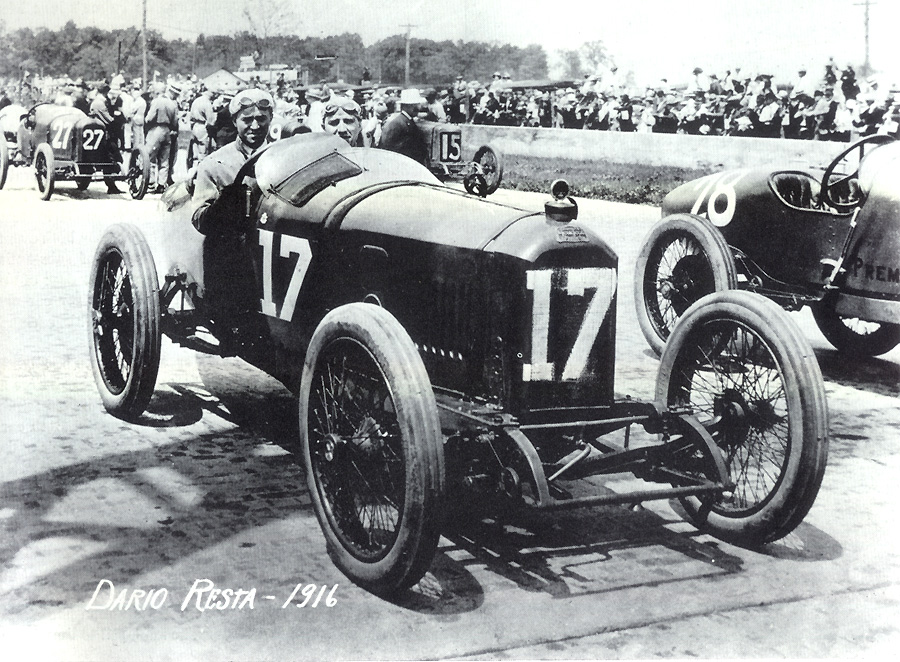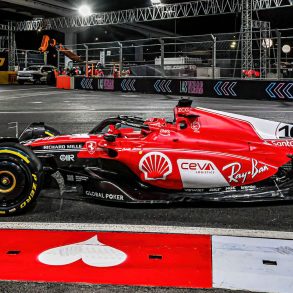Peugeot 1912 L76
Car: Peugeot 1912 L76 / Engine: 4-Cylinder In-line / Maker: Peugeot / Bore X Stroke: 92 mm X 169 mm / Year: 1912 / Capacity: 4,400 cc / Class: Grand Prix / Power: 112 bhp at 2,800 rpm / Wheelbase: 2,700 mm / Track: Front: 1350 mm Rear: 1350 mm / Top Speed: 116 mph / Tires: Tires were by Dunlop with 875 x 105 mm front, 880 x 120 mm rear.
The inspiration for the new Grand Prix Peugeots actually came from a race that they lost. Peugeot up to that time had a fairly successful stint in voiturette or light-car racing as Lion-Peugeot. Their drivers, Georges Boillot and Jules Goux yearned to move up to the top tier Grand Prix cars, at that time led by the 16-liter FIATs. At the 1910 Coupe des Voiturettes at Boulogne where they were soundly beaten by Paul Zuccarelli’s Hispano-Suiza. Zuccarelli also wished to race Grand Prix cars and convinced the Peugeot drivers that he had some ideas that could make their dream happen. Goux who besides himself had many family members who worked at Peugeot and had served as a chauffeur for the founder pleaded with Robert Peugeot to sign Zuccarelli to replace motorcycle star, Cesare Giuppone who had recently died.
As soon as Zuccarelli was ensconced at Peugeot he and his co-conspirators developed their plans and presented them to Robert Peugeot. Peugeot already controlled a successful industrial concern and didn’t consider racing to be essential to the firm yet he backed the erstwhile drivers, some said on a lark. The drivers energized by this small vote of confidence needed someone who could put their ideas on paper but they could not get any help from within the firm and turned to a young Swiss draughtsman by the name of Ernest Henry.
They were allowed £4,000 per car to be built to the new regulations emanating from the A.C.F that set a maximum capacity of 4-cylinders with each not exceeding 110 x 200 mm. bore and stroke, or about 7.6 litres. The advantage of this dynamic team, led by Zuccarelli was their freedom from any “baggage”. Since none had much experience in designing production cars they started from a clean slate when designing the first cars and took the latest ideas and melded them into a 4-valve per cylinder, dual overhead camshaft engine with a hemi-spherical combustion chamber, desmodronic valve gear and a central spark plug. Later dry-sump lubrication was added.
Meanwhile the engineers at the firm were outraged, they denied the group any use of the firms main factories and so much as called them charlatans. The idea that a group of amateurs, bereft of a licensed engineer could even hope of toppling the mighty 16 litre FIATs with a car half its size seemed ludicrous. Yet it was these charlatans who would produce the legendary “Racing Peugeots of 1912-1919”, considered by many the forefather of modern racing cars.
The first car was built in 1911 and the results were not long in coming with Boillot winning the 1912 Grand Prix of France followed by victories at the Coupe de la Sarthe and the Indianapolis 500 the following year. Tragedy would strike the team when Zuccarelli, carrying out test on a stretch of the Route Nationale could not avoid a hay wagon that had entered his path from a side-road. the wagon driven by a Frenchman who reportedly was deaf and didn’t hear the race car baring down upon him.
Later in an interview Boillot remarked: “The racing cars were produced by a special staff, of which Ernest Henry, my late friend Zuccarelli, my companion driver Goux, and myself are the leading members. In Zuccarelli’s sad and untimely death we not only lost a close friend, but an engineer of considerable ability. There is only one sad feature about my victory in the Grand Prix (Amiens) – it is that Zuccarelli is not here to share in the honor with us. Zuccarelli and I supplied the main idea for the car. Henry was responsible for the drawings, and it is to him that we owe the beautiful lines of the cars.”
The team persevered with a 3-litre voiturette as well as a 5.6 litre Grand Prix car winning numerous races and making 1913 their most successful year.. Many consider the 3-litre car Peugeot’s masterpiece that was producing for that time an astonishing 30 bhp/litre. Ironically Peugeot management made it a policy to sell the GP cars as soon as they had run a race or two and a buyer had come forward. The market for these world beating cars were as you can imagine quite vast and soon copies of Grand Prix Peugeots could be seen on both sides of the Atlantic. Sunbeam of England went so far as to taking apart and copiying every piece of their recently purchased example only to put it together again and loan it to other British engineers, somewhat akin to what transpired when the Mercedes and Auto Union Silver Arrows cars fell into Allied hands after World War II.
Victories continued in 1914 leading up that years Grand Prix. It is some how fitting, almost Gallic that their brightest star, Boillot would have his greatest race in defeat. Some have said that the Peugeot team were the victims of over confidence, being unbeatable the year before they may though it would have been enough just to show up for that is basically what they did. Only just returning from their triumph at Indianapolis the team had time to take part in a meager practice period that was allowed at the last moment and only due to the French teams late arrival. The Mercedes team on the other hand had scouted the course weeks before and had arrived fully prepared. The results followed as the Germans finished 1-2-3.
The First World War brought racing to an end in Europe but the rivalry continued in America where the two makes were raced by Dario Resta and Ralph de Palma with the Peugeots able to score a few more victories. The war claimed the life of the great Boillot and with the earlier death of Zuccarelli the fire had gone out of the team never to return.

























